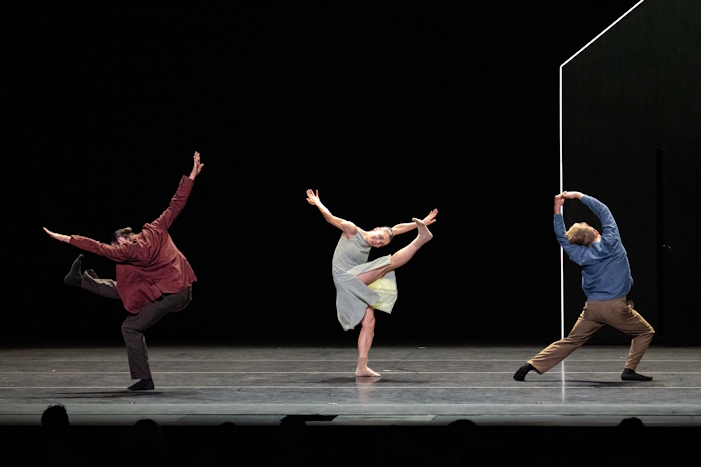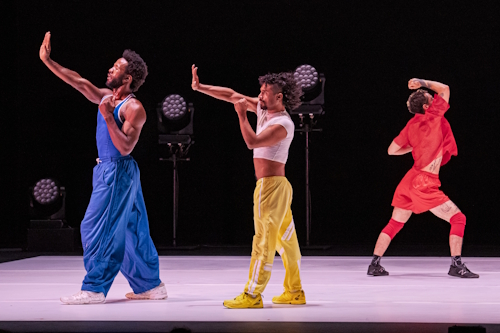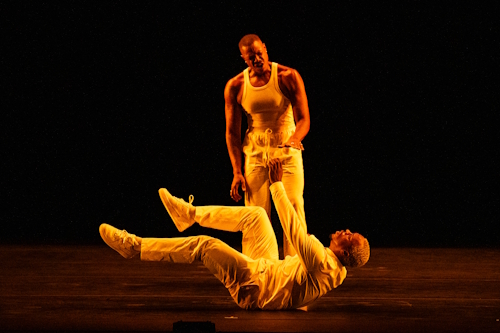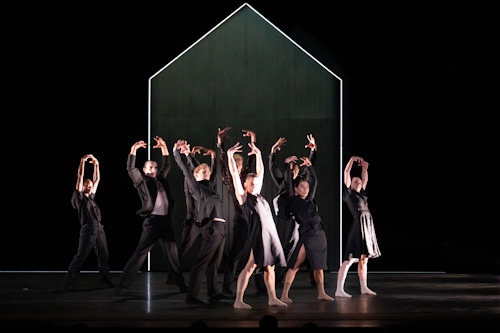September 18, 2025
New York City Center
Dog Rising by Québécoise choreographer Clara Furey for Bent Hollow Compagnie, which opened the second programme of this year’s Fall for Dance season in New York, presents a hypnotic polyphony of pulsating bodies that apparently reflects how sound vibrations penetrate the bones, the way our skeletons absorb shocks.
The trio of Baco LePage Acosta, Brian Mendez and Jontae McCrory certainly show a lot of energy. The choreography is relentless, an endless repetition of gesture and movement. Many appear initially to be boxing references. There are punches, ducks, bouncing on the toes, all as if sparring.
And so it goes on… and on. Shoulders pump, arms and palms push, knees bend, feet and hips bounce, chests pump. Repeatedly. It’s non-stop. The stamina and effort are there for all to see, and have to be admired. The unison moments too, which are very together. The physicality is closely linked to the soundtrack, composed by Furey’s brother Tomas, his electro-acoustic, percussive composition being as relentless as the choreography.
While one can see movement connections between the trio, they appear totally detached in every other way. The piece was created in 2020 at the height of the Covid pandemic, which goes some way to explaining the lack of physical contact but, locked in their own worlds, they also appear detached from the viewer. Although we are definitely watching human beings, there is no connection despite the movement not being in any sense robotic.
Dog Rising does initially pique the curiosity. But it very soon becomes apparent that it’s not really going anywhere or saying anything. Far from being mesmerising, it very quickly becomes rather monotonous.
At one point, one of the dancers jumps repeatedly, palms and eyes upturned to the sky as if reaching for something. Maybe an escape route, a way out, I couldn’t help thinking.
It does get marginally more interesting towards the end when a few new and more freuqnrly changing movement elements and lighting effects are introduced, although quite why the latter includes flashes is unclear. But it’s all relative.
Perhaps Dog Rising got a little lost in the vastness of City Center. Perhaps it works better in a smaller space. But I’m going to take a lot of convinving.
Thankfully, things picked up somewhat with Resurrection by choreographer-dancer Charles ‘Lil Buck’ Riley and bass-baritone Davóne Tines, a work in which Baptist spiritual song meets very 21st-century dance.
Buck pioneered Memphis-Jookin, a freestyle street dance rooted in that city’s culture. With its intricate footwork, glides, spins, and a unique, angular upper-body movement that isolates itself from the lower body, it’s not unlike the sort of dance Michale Jackson was known for. And Buck is superb, dancing with strength and clarity, but with a wonderfully fluid body that at times seems devoid of its skeleton.
He was also totally at one with equally terrific Tines whose singing of Caroline Shaw’s adaptation of Albert Brumley’s Baptist song ‘I’ll Fly Away’ (named in the programme as ‘By and By’) made one shiver with pleasure. And while the song is often sung at funerals, it is really about the joy of going to a better place.
With the performers in white against a black background, it may have been simply staged, but Resurrection drew you in beautifully.
The evening closed with Hubbard Street Dance from Chicago in Johan Inger’s Impasse, a work about shared humanity, peer pressure, and sense of self. Those could be deep topics, and the themes are certainly there, but Inger equally delivers everything with a light touch. And it’s perfectly possible to just sit back and enjoy the fantastic dancers and dancing for what they are.
A clapboard house, or is it a barn, is outlined in neon light. Against it a girl’s face is pressed to the wall. A hand reaches out from the door and strokes her hair. It’s comic, but also laced with film noir. French-Lebanese composer and trumpeter Ibrahim Maalouf’s seductive music is jazzy and, before long, she joined by two men, all in normal streetwear. The mood is playful, the dance hugely appealing while giving no hint of what is to come.
One by one, figures dressed in black appear from the building. The choreography becomes more aggressive. When the original threesome reappear, now also in black, the message is that they have conformed.
A rumba marks the arrival of a second, smaller house, from which emerges a bizarre group of figures including a woman in a sequined leotard and blue-feather headdress and a rather sad looking clown. As the colourful scene becomes increasingly chaotic, the initially so innocent threesome again follow along and join in. o.
But Inger does suggest there is an escape route. As a scrim very, very slowly descends, the threesome manage to escape (just!) despite the best efforts of the others to drag them back. Standing alongside a very small third house, they look quizzically at each other and us in what was a simply wonderful end to the evening.





